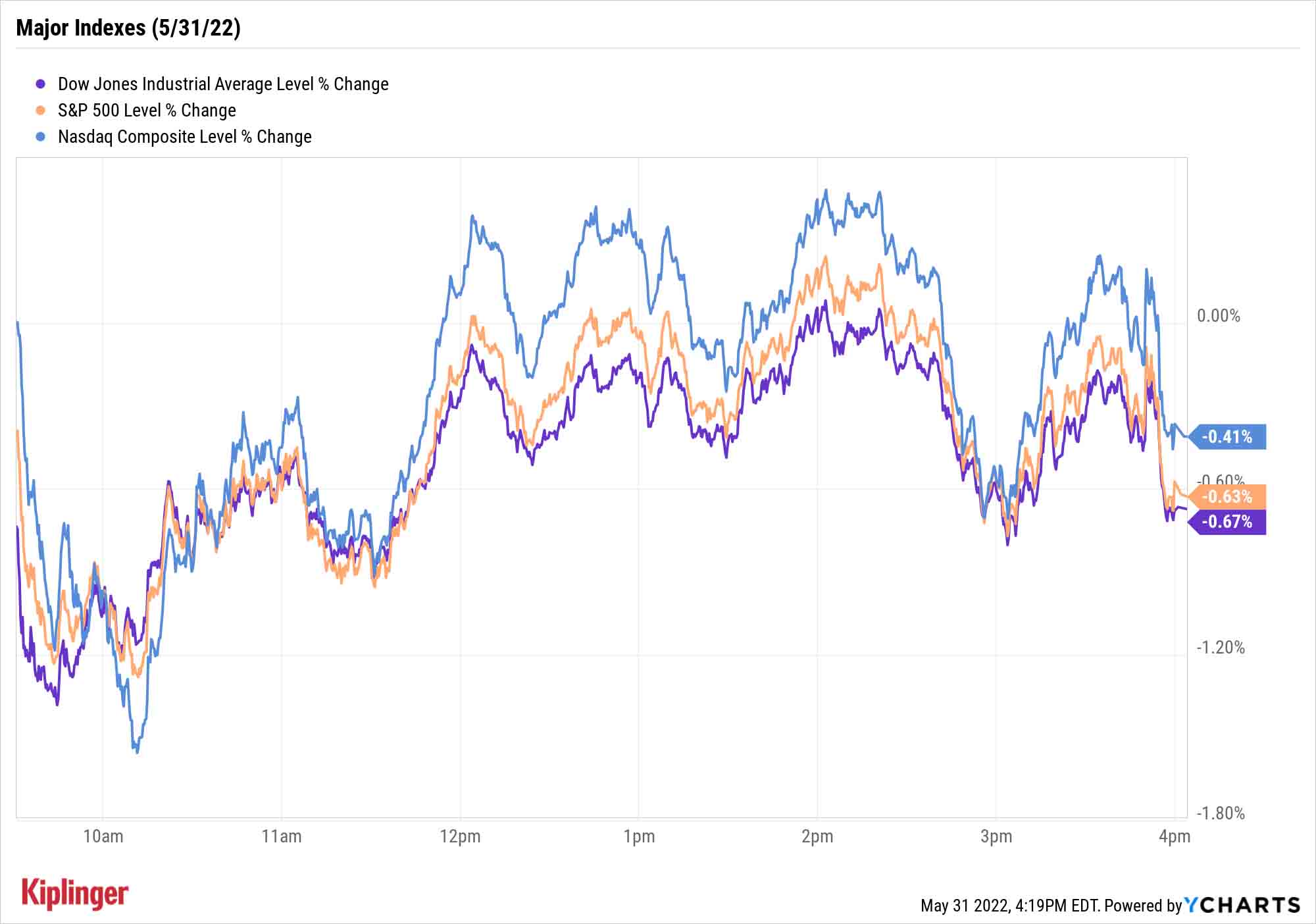Stock Market Today: May Delivers One Final Roller-Coaster Ride
The major indexes finished lower Tuesday amid a resurgence in bond yields and a higher-than-expected inflation reading.


May's final session was a fitting one for a wild month, with the major indexes swinging up and down Tuesday before closing in the red.
Over the Memorial Day weekend, Federal Reserve Governor Christopher Waller said during a speech in Germany that he expects 50-basis-point interest-rate increases to continue into the later part of the year – a departure from previous dovish statements from Fed members suggesting hikes of that magnitude would be limited to the next two summer meetings.
That sent bond yields spiking Tuesday, with the 10-year Treasury yield reaching as high as 2.88%.

Sign up for Kiplinger’s Free E-Newsletters
Profit and prosper with the best of expert advice on investing, taxes, retirement, personal finance and more - straight to your e-mail.
Profit and prosper with the best of expert advice - straight to your e-mail.
"It is really too bad that the Fed can't learn to speak with one voice on this," says Dean Smith, portfolio manager and chief strategist of investment technology platform FolioBeyond. "The constant seesaw from hawkish to dovish is increasing uncertainty in the market and in the economy. The 'buy-the-dip' mentality that has been nurtured in a generation of investors is being supported and encouraged by these carelessly dovish Fed speakers. In the end, all it does is make their job harder."
Also Tuesday, the Federal Reserve's preferred gauge of inflation – the core personal consumption expenditures (PCE) price index – rose by 4.9% year-over-year and 0.34% month-over-month, which was more than expected.
"The April increase represents the third month of more muted, but still solid, increases," UBS analysts note.
The consumer discretionary (+0.5%) and communication services (-0.1%) sectors were the best performers in a largely down day. That was largely thanks to Amazon.com (AMZN, +4.4%), whose shareholders on Friday approved a 20-for-1 AMZN stock split set to take effect June 6; that lifted spirits at Alphabet (GOOGL, +1.3%), which intends on executing its own 20-for-1 GOOGL/GOOG stock split in July. (Indeed, 2022 is shaping up to be quite a busy year for stock splits.)
That helped the Nasdaq Composite deliver the smallest loss among the major indexes Tuesday: a 0.4% decline to 12,081. However, the tech-heavy index posted a 2.1% decline for the entire month. The S&P 500 (-0.6% to 4,132) finished May marginally higher, however, as did the Dow Jones Industrial Average (-0.7% to 32,990).

Other news in the stock market today:
- The small-cap Russell 2000 slid 1.3% to 1,864.
- Gold futures declined 0.5% to $1,848.40 ounce, clinching the yellow metal's second consecutive monthly decline.
- U.S. crude oil futures were down 0.4% to $114.67 per barrel, good for a nearly 10% gain in the commodity across May. Oil had a back-and-forth session; gains from the European Union's agreement to ban most Russian crude oil imports were negated after a report that OPEC+ was considering suspending Russia from its oil-output deal.
- Bitcoin rebounded hard during the long weekend, improving by roughly 10% to $31,649 from its Friday afternoon prices. (Bitcoin trades 24 hours a day; prices reported here are as of 4 p.m.)
As Red Flags Mount, Stock Up on Quality
A few cracks are starting to show in the American economic engine. Wealth management firm Glenmede's Jason Pride and Michael Reynolds say that several U.S. leading indicators are signaling slowing growth.
"Last week, the Flash Composite PMI, which tracks the manufacturing and services sectors, fell," they say. "The latest round of retail earnings reflects slowing demand as consumers grapple with higher costs and pivot their spending from goods to services. The housing market is starting to show signs of softening as sales of newly built homes fell 16.6% in April from March (rising mortgage rates are reducing buyer demand)."
This has Glenmede's recession model projecting a 10% probability of recession within the next 12 months, up from 0% projections to start the year.
That's the kind of environment that, unlike the year-plus of rip-roaring gains out of the COVID bottom, necessitates selectivity – every stock pick isn't just going to stick to the wall, so to speak. Defensively minded investors, for instance, will want to focus on stocks that seem best positioned to perform in bear markets. Dip-buyers will need to make a distinction between "cheap" and "undervalued" – the latter you're likely to find in these high-growth-potential stocks boasting low prices.
And on the whole, it pays to invest in the best of the best. These 10 S&P 500 stocks, for instance, represent the best the index has to offer right now, in the eyes of Wall Street's analyst community. Each of them is teeming with bullish pros who believe they have anywhere between 20% to 110% upside over the next year.
Get Kiplinger Today newsletter — free
Profit and prosper with the best of Kiplinger's advice on investing, taxes, retirement, personal finance and much more. Delivered daily. Enter your email in the box and click Sign Me Up.
Kyle Woodley is the Editor-in-Chief of WealthUp, a site dedicated to improving the personal finances and financial literacy of people of all ages. He also writes the weekly The Weekend Tea newsletter, which covers both news and analysis about spending, saving, investing, the economy and more.
Kyle was previously the Senior Investing Editor for Kiplinger.com, and the Managing Editor for InvestorPlace.com before that. His work has appeared in several outlets, including Yahoo! Finance, MSN Money, Barchart, The Globe & Mail and the Nasdaq. He also has appeared as a guest on Fox Business Network and Money Radio, among other shows and podcasts, and he has been quoted in several outlets, including MarketWatch, Vice and Univision. He is a proud graduate of The Ohio State University, where he earned a BA in journalism.
You can check out his thoughts on the markets (and more) at @KyleWoodley.
-
 Stock Market Today: Stocks Soar on China Trade Talk Hopes
Stock Market Today: Stocks Soar on China Trade Talk HopesTreasury Secretary Bessent said current U.S.-China trade relations are unsustainable and signaled hopes for negotiations.
By Karee Venema
-
 2026 Disney Dining Plan Returns: Free Dining for Kids & Resort Benefits
2026 Disney Dining Plan Returns: Free Dining for Kids & Resort BenefitsPlan your 2026 Walt Disney World vacation now. Learn about the returning Disney Dining Plan, how kids aged three to nine eat free, and the exclusive benefits of staying at a Disney Resort hotel.
By Carla Ayers
-
 Stock Market Today: Stocks Soar on China Trade Talk Hopes
Stock Market Today: Stocks Soar on China Trade Talk HopesTreasury Secretary Bessent said current U.S.-China trade relations are unsustainable and signaled hopes for negotiations.
By Karee Venema
-
 Stock Market Today: Dow Drops 971 Points as Powell Pressure Ramps Up
Stock Market Today: Dow Drops 971 Points as Powell Pressure Ramps UpPresident Trump is increasing his attacks against Jerome Powell, insisting the Fed chair cut interest rates.
By Karee Venema
-
 Stock Market Today: No 'Powell Put'? No Problem
Stock Market Today: No 'Powell Put'? No ProblemInvestors, traders and speculators look beyond both another Trump post and more signs of slowing economic activity.
By David Dittman
-
 What Is the Buffett Indicator?
What Is the Buffett Indicator?"It is better to be roughly right than precisely wrong," writes Carveth Read in "Logic: Deductive and Inductive." That's the premise of the Buffett Indicator.
By Charles Lewis Sizemore, CFA
-
 Stock Market Today: Dow Drops 699 Points After Powell Speech
Stock Market Today: Dow Drops 699 Points After Powell SpeechFed Chair Powell warned of a slowing economy and higher inflation but said the central bank isn't ready to cut rates just yet.
By Karee Venema
-
 Stock Market Today: Stocks Struggle Amid Tariff Uncertainty
Stock Market Today: Stocks Struggle Amid Tariff UncertaintyBoeing dropped after China suspended new aircraft orders, while Bank of America and Citi climbed on earnings beats.
By Karee Venema
-
 Stock Market Today: Stocks Gain on Tech, Auto Tariff Talk
Stock Market Today: Stocks Gain on Tech, Auto Tariff TalkThe Trump administration said late Friday that it will temporarily halt tariffs on some Chinese tech imports.
By Karee Venema
-
 Stock Market Today: Stocks Surge to Close a Volatile Week
Stock Market Today: Stocks Surge to Close a Volatile WeekIt was another day with a week's worth of both news and price action, but it ended on a strongly positive note.
By David Dittman